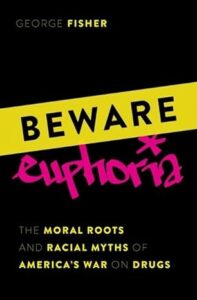Beware Euphoria: The Moral Roots and Racial Myths of America’s War on Drugs
Down a gray and gritty alley in San Francisco’s Chinatown, a Victorian-era investigator waved away the sickly fumes emanating from forbidden opium dens, stopped before an unmarked door and rapped on it with his cane.

A fictional sleuth? No, it’s a real-life character in George Fisher’s compelling introduction to his detailed study of our anti-intoxicant laws. Beware Euphoria: The Moral Roots and Racial Myths of America’s War on Drugs, published by Oxford University Press on February 9, 2024.
Fisher, who joined the SLS faculty in 1995 and has been the Judge John Crown Professor of Law since 2004, is relaying an 1892 account by Frederick J. Masters, a Methodist minister and former missionary to China. Masters was fact-finding on Jackson Street in Chinatown in hopes of extending his church’s alcohol temperance movement to opium. He found a cellar where “stupefying smoke fills the hovel, through the gloom of which the feeble yellow light of three or four opium lamps struggles hopelessly to penetrate.”
Rapping on history’s door as Masters did at the opium den, Fisher shines a beam brighter than those feeble lamps through the fallacies, cant and humbug that warp much of what we think we know about efforts to suppress drug use.
Before coming to Stanford, where he co-founded the Criminal Prosecution Clinic, Fisher worked as an assistant district attorney in Massachusetts, an experience that roused his curiosity about the origins of damaging U.S. drug laws. “Violence, theft and drug crimes were my beat,” he says in an interview. Fisher came to see that the justice system was distorted by drug crime prosecutions, from the harms of invasive investigations and the rise of related crimes like theft and prostitution to harsh parole conditions that rolled forward the cycle of broken lives.
“I’d been thinking about drug crimes since the beginning of my career,” he says. “How did this all come to be?”
Finding out was a monumental academic slog that Fisher launched in 2000 and pursued even as drug laws began to shift away from the harshly inflexible toward decriminalization. “I never thought I’d see cannabis legalized, but I was proved wrong by events. Eyes began to open to how laws became weapons against communities of color.”

As he worked on the book that would cap his 30-year career, Fisher’s role as a historian drew on his life as a practicing lawyer. It began with a clerkship for Judge Stephen G. Breyer, BA ’59, who then sat on the 1st U.S. Circuit Court of Appeals. Fisher’s books on the criminal law’s nuts and bolts include Evidence, most recently revised in 2023; Criminal Practice: A Handbook for New Advocates with Ingrid Eagly and Ronald Tyler (2021); Plea Bargaining’s Triumph: A History of Plea Bargaining in America (2003); and The Crime Conundrum: Essays on Criminal Justice, coedited with Lawrence Friedman (1997), and the article The Jury’s Rise as Lie Detector (1997).
Meanwhile, Fisher’s practical coursework at the Criminal Prosecution Clinic has helped students gain case preparation and courtroom skills—first in trial advocacy classes and then in actual felony prosecutions in conjunction with the Santa Clara County District Attorney’s office.
His rapport with students has earned Fisher the John Bingham Hurlbut Award for Excellence in Teaching in 1999, 2003, 2007, and 2011.
Toward the end of Beware Euphoria, Fisher returns to his saga’s starting point in the Bay Area. In 2004, Oakland, what he calls “San Francisco’s grittier sibling,” became the first city in the United States to license a medical cannabis dispensary. Twelve years later, the city enacted an equity program for recreational dispensary licenses, half of which were reserved for persons who had served time for marijuana offenses or had lived in neighborhoods with a high rate of marijuana-related arrests. The purpose: reparations for drug policies that disproportionally punished people of color.
“The people in power here were largely voters disaffected by drug prosecutions,” Fisher says.
His research led him to examine the paradox of our culture’s curious embrace of alcohol and its rejection of other recreational intoxicants. And, taking the tale to the roots of the race and class injustices many believe underlie anti-drug legislation, he found that early drug laws were passed to shield white people from the snares of addiction and abuse. The laws’ utility in advancing racial repression came later.
Fundamentally, Fisher argues, ancient religious dogmas are in play, some of them spurious ascriptions to St. Augustine. “We have banned recreational intoxicants not because they harm us or give pleasure to groups we despise, but because of our cultural euphoria taboo—an old and deep and essentially moral aversion to pleasures that numb the mind.”
The earliest drug laws in the United States did not target the Chinese, African Americans and Mexicans who were often linked to opium, cocaine and marijuana, Fisher reports. The bans focused on white folks and were written by white lawmakers “to protect the morals of their own racial kin,” especially when a drug took “respectable women and youth in its clutches.”
Some early reports on opium smoking in America focused on the threat of promiscuity and the specter of miscegenation, dire tales intended to rile readers and lend support to prohibitions. One, quoted in Beware Euphoria, described “the sickening sight of young white girls from sixteen to twenty years of age lying half-undressed on the floor or couches smoking with their ‘lovers.’ Men and women, Chinese and white people, mix indiscriminately in Chinatown smoking houses.”
Reinforcing the now common belief that racial bias drove drug legislation was an infamous New York Times headline from 1914: “Negro Cocaine ‘Fiends’ Are a New Southern Menace.” Fisher calls it perhaps the most quoted artifact in the history of America’s war against drugs.
Cannabis was also a culprit, and Harry J. Anslinger its foremost propagandist of doom. “Assassin of youth,” thundered the Federal Bureau of Narcotics commissioner in the 1930s about marijuana, claiming it led to suicide, rape and murder. Fisher is unsparing as he describes the “justly maligned” crusader and his overheated diatribe. “His round head plopped neckless atop a fireplug torso, Anslinger earned the scorn of modern drug-war historians, who tag him with inciting anti-pot panic.”
Fisher’s engaging prose and crisp storytelling have won him awards for excellence in teaching and can be traced to his courtroom successes. “For a jury, you have to reconstruct a story as a historian does. Those sets of skills recur in the classroom and in writing,” he says. “It doesn’t help to persuade people or communicate a thought if their eyes glaze over.”
The book ends with a state-by-state account of the recent debates over decriminalization, followed by cautions about the risks of rebranding euphoriants as purely benign. Alcohol, Fisher points out, has been rehabilitated post-Prohibition as a social lubricant, but one challenge for those promoting cannabis, for example, “is persuading skeptics it can enliven and enrich conversation without dumbing it down or snuffing it out.” Then too is the risk to young people. “Accounts of Ivy-bound youth sidelined by pot,” Fisher writes, “seemingly the stuff of anecdote and fearmongering, are too rooted in research for prudent parents to ignore.”
Moreover, the old moral precepts against mind-disabling conduct haven’t entirely vanished. Fisher cites New York Times columnist David Brooks who warned in 2014 that those aspiring to become responsible adults will need “the powers of reason, temperance, and self-control—not qualities one associates with being high.”
